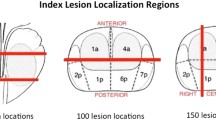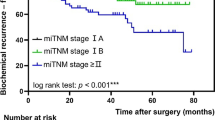Abstract
Purpose
Prostate-specific membrane antigen (PSMA) positron emission tomography (PSMA-PET) is an ideal tool for staging and restaging of prostate cancer (PCa). This study was designed to investigate the prognostic role of preoperative 68Ga-PSMA-11 PET/CT in predicting pathological upgrading from multiparametric magnetic resonance imaging–targeted biopsy (mpMRI-TB) to final radical prostatectomy (RP) specimens in patients with localized PCa.
Methods
A total of 67 biopsy-confirmed localized PCa patients with mpMRI and 68Ga-PSMA-11 PET/CT prior to RP were included. Clinical and imaging characteristics derived from mpMRI and PET/CT were compared in patients with or without pathological upgrading. Predictors for pathological upgrading were evaluated by using univariate and multivariable analyses. A prediction model was developed based on the identified parameters and validated using internal validation.
Results
Pathological upgrading from mpMRI-TB to final RP specimens occurred in 38.8% (26/67) of the patients. Multivariable logistic regression analysis showed SUVmax (OR: 1.223, 95% CI 1.068–1.399, p = 0.003); highest tumor grade at mpMRI-TB, ISUP grade group (ISUP GG) 1 vs. 4 (OR: 0.11, 95% CI 0.000–0.452, p = 0.018) and ISUP GG 2 vs. 4 (OR: 0.16, 95% CI 0.001–0.252, p = 0.003); and multifocality on PET/CT (OR: 9.821, 95% CI 1.438–67.085, p = 0.02) were independent risk factors for pathological upgrading. Our developed prediction model based on the identified parameter showed good calibration at internal validation (mean absolute error = 0.033).
Conclusion
68Ga-PSMA-11 PET/CT was found to be an ideal biomarker for the prediction of pathological upgrading from mpMRI-TB to RP, especially for patients with lower tumor grade at mpMRI-TB.


Similar content being viewed by others
References
Cornford P, van den Bergh RCN, Briers E, Van den Broeck T, Cumberbatch MG, De Santis M, et al. EAU-EANM-ESTRO-ESUR-SIOG guidelines on prostate cancer. Part II-2020 update: treatment of relapsing and metastatic prostate cancer. Eur Urol. 2020. doi:https://doi.org/10.1016/j.eururo.2020.09.046.
Brockman JA, Alanee S, Vickers AJ, Scardino PT, Wood DP, Kibel AS, et al. Nomogram predicting prostate cancer-specific mortality for men with biochemical recurrence after radical prostatectomy. Eur Urol. 2015;67:1160–7. https://doi.org/10.1016/j.eururo.2014.09.019.
Kasivisvanathan V, Rannikko AS, Borghi M, Panebianco V, Mynderse LA, Vaarala MH, et al. MRI-targeted or standard biopsy for prostate-cancer diagnosis. N Engl J Med. 2018;378:1767–77. https://doi.org/10.1056/NEJMoa1801993.
Cohen MS, Hanley RS, Kurteva T, Ruthazer R, Silverman ML, Sorcini A, et al. Comparing the Gleason prostate biopsy and Gleason prostatectomy grading system: the Lahey Clinic Medical Center experience and an international meta-analysis. Eur Urol. 2008;54:371–81. https://doi.org/10.1016/j.eururo.2008.03.049.
van der Leest M, Cornel E, Israel B, Hendriks R, Padhani AR, Hoogenboom M, et al. Head-to-head comparison of transrectal ultrasound-guided prostate biopsy versus multiparametric prostate resonance imaging with subsequent magnetic resonance-guided biopsy in biopsy-naive men with elevated prostate-specific antigen: a large prospective multicenter clinical study. Eur Urol. 2019;75:570–8. https://doi.org/10.1016/j.eururo.2018.11.023.
Ahdoot M, Wilbur AR, Reese SE, Lebastchi AH, Mehralivand S, Gomella PT, et al. MRI-targeted, systematic, and combined biopsy for prostate cancer diagnosis. N Engl J Med. 2020;382:917–28. https://doi.org/10.1056/NEJMoa1910038.
Hofman MS, Lawrentschuk N, Francis RJ, Tang C, Vela I, Thomas P, et al. Prostate-specific membrane antigen PET-CT in patients with high-risk prostate cancer before curative-intent surgery or radiotherapy (proPSMA): a prospective, randomised, multicentre study. Lancet. 2020;395:1208–16. https://doi.org/10.1016/S0140-6736(20)30314-7.
Lopci E, Piccardo A, Lazzeri M. Prostate cancer imaging and therapeutic alternatives with highly specific molecular 'probes'. BJU Int. 2019;124:188–9. https://doi.org/10.1111/bju.14713.
Fendler WP, Calais J, Eiber M, Flavell RR, Mishoe A, Feng FY, et al. Assessment of 68Ga-PSMA-11 PET accuracy in localizing recurrent prostate cancer: a prospective single-arm clinical trial. JAMA Oncol. 2019;5:856–63. https://doi.org/10.1001/jamaoncol.2019.0096.
Lopci E, Lughezzani G, Castello A, Saita A, Colombo P, Hurle R, et al. Prospective evaluation of (68)Ga-labeled prostate-specific membrane antigen ligand positron emission tomography/computed tomography in primary prostate cancer diagnosis. Eur Urol Focus. 2020. https://doi.org/10.1016/j.euf.2020.03.004.
Lopci E, Guazzoni G, Lazzeri M. (68)Ga prostate-specific membrane antigen PET/CT for primary diagnosis of prostate cancer: complementary or alternative to multiparametric MR imaging. Radiology. 2018;287:725–6. https://doi.org/10.1148/radiol.2017172607.
Lopci E, Saita A, Lazzeri M, Lughezzani G, Colombo P, Buffi NM, et al. (68)Ga-PSMA positron emission tomography/computerized tomography for primary diagnosis of prostate cancer in men with contraindications to or negative multiparametric magnetic resonance imaging: a prospective observational study. J Urol. 2018;200:95–103. doi:https://doi.org/10.1016/j.juro.2018.01.079.
Chen M, Zhang Q, Zhang C, Zhao X, Marra G, Gao J, et al. Combination of (68)Ga-PSMA PET/CT and multiparametric MRI improves the detection of clinically significant prostate cancer: a lesion-by-lesion analysis. J Nucl Med. 2019;60:944–9. https://doi.org/10.2967/jnumed.118.221010.
Zamboglou C, Carles M, Fechter T, Kiefer S, Reichel K, Fassbender TF, et al. Radiomic features from PSMA PET for non-invasive intraprostatic tumor discrimination and characterization in patients with intermediate- and high-risk prostate cancer - a comparison study with histology reference. Theranostics. 2019;9:2595–605. https://doi.org/10.7150/thno.32376.
Cysouw MCF, Jansen BHE, van de Brug T, Oprea-Lager DE, Pfaehler E, de Vries BM, et al. Machine learning-based analysis of [(18)F]DCFPyL PET radiomics for risk stratification in primary prostate cancer. Eur J Nucl Med Mol Imaging. 2020. https://doi.org/10.1007/s00259-020-04971-z.
Chen M, Qiu X, Zhang Q, Zhang C, Zhou Y, Zhao X, et al. PSMA uptake on [68Ga]-PSMA-11-PET/CT positively corrects with prostate cancer aggressiveness. Q J Nucl Med Mol Imaging. 2019. doi:https://doi.org/10.23736/S1824-4785.19.03172-8.
Roberts MJ, Morton A, Donato P, Kyle S, Pattison DA, Thomas P, et al. (68)Ga-PSMA PET/CT tumour intensity pre-operatively predicts adverse pathological outcomes and progression-free survival in localised prostate cancer. Eur J Nucl Med Mol Imaging. 2020. doi:https://doi.org/10.1007/s00259-020-04944-2.
Koseoglu E, Kordan Y, Kilic M, Sal O, Seymen H, Kiremit MC, et al. Diagnostic ability of Ga-68 PSMA PET to detect dominant and non-dominant tumors, upgrading and adverse pathology in patients with PIRADS 4-5 index lesions undergoing radical prostatectomy. Prostate Cancer Prostatic Dis. 2020. https://doi.org/10.1038/s41391-020-00270-8.
Zhang Q, Wang W, Zhang B, Shi J, Fu Y, Li D, et al. Comparison of free-hand transperineal mpMRI/TRUS fusion-guided biopsy with transperineal 12-core systematic biopsy for the diagnosis of prostate cancer: a single-center prospective study in China. Int Urol Nephrol. 2017;49:439–48. https://doi.org/10.1007/s11255-016-1484-8.
Zhang Q, Zang S, Zhang C, Fu Y, Lv X, Zhang Q, et al. Comparison of (68)Ga-PSMA-11 PET-CT with mpMRI for preoperative lymph node staging in patients with intermediate to high-risk prostate cancer. J Transl Med. 2017;15:230. https://doi.org/10.1186/s12967-017-1333-2.
Turkbey B, Rosenkrantz AB, Haider MA, Padhani AR, Villeirs G, Macura KJ, et al. Prostate Imaging Reporting and Data System Version 2.1: 2019 update of Prostate Imaging Reporting and Data System Version 2. Eur Urol. 2019;76:340–51. https://doi.org/10.1016/j.eururo.2019.02.033.
Donati OF, Mazaheri Y, Afaq A, Vargas HA, Zheng J, Moskowitz CS, et al. Prostate cancer aggressiveness: assessment with whole-lesion histogram analysis of the apparent diffusion coefficient. Radiology. 2014;271:143–52. https://doi.org/10.1148/radiol.13130973.
Fanti S, Goffin K, Hadaschik BA, Herrmann K, Maurer T, MacLennan S, et al. Consensus statements on PSMA PET/CT response assessment criteria in prostate cancer. Eur J Nucl Med Mol Imaging. 2020. https://doi.org/10.1007/s00259-020-04934-4.
Marra G, Zhuang J, Beltrami M, Calleris G, Zhao X, Marquis A, et al. Transperineal freehand multiparametric MRI fusion targeted biopsies under local anaesthesia for prostate cancer diagnosis: a multicentre prospective study of 1014 cases. BJU Int. 2021;127:122–30. https://doi.org/10.1111/bju.15121.
Epstein JI, Egevad L, Amin MB, Delahunt B, Srigley JR, Humphrey PA, et al. The 2014 International Society of Urological Pathology (ISUP) consensus conference on Gleason grading of prostatic carcinoma: definition of grading patterns and proposal for a new grading system. Am J Surg Pathol. 2016;40:244–52. https://doi.org/10.1097/PAS.0000000000000530.
Bakavicius A, Daniunaite K, Zukauskaite K, Barisiene M, Jarmalaite S, Jankevicius F. Urinary DNA methylation biomarkers for prediction of prostate cancer upgrading and upstaging. Clin Epigenetics. 2019;11:115. https://doi.org/10.1186/s13148-019-0716-z.
Kerr KF, Brown MD, Zhu K, Janes H. Assessing the clinical impact of risk prediction models with decision curves: guidance for correct interpretation and appropriate use. J Clin Oncol. 2016;34:2534–40. https://doi.org/10.1200/JCO.2015.65.5654.
Xu N, Wu YP, Li XD, Lin MY, Zheng QS, Chen SH, et al. Risk of upgrading from prostate biopsy to radical prostatectomy pathology: is magnetic resonance imaging-guided biopsy more accurate? J Cancer. 2018;9:3634–9. https://doi.org/10.7150/jca.26791.
Shoag JE, Cai PY, Gross MD, Gaffney C, Li D, Mao J, et al. Impact of prebiopsy magnetic resonance imaging on biopsy and radical prostatectomy grade concordance. Cancer. 2020;126:2986–90. https://doi.org/10.1002/cncr.32821.
Calio BP, Sidana A, Sugano D, Gaur S, Maruf M, Jain AL, et al. Risk of upgrading from prostate biopsy to radical prostatectomy pathology-does saturation biopsy of index lesion during multiparametric magnetic resonance imaging-transrectal ultrasound fusion biopsy help? J Urol. 2018;199:976–82. https://doi.org/10.1016/j.juro.2017.10.048.
Mesko S, Marks L, Ragab O, Patel S, Margolis DA, Demanes DJ, et al. Targeted prostate biopsy Gleason score heterogeneity and implications for risk stratification. Am J Clin Oncol. 2018;41:497–501. https://doi.org/10.1097/COC.0000000000000308.
Demirci E, Kabasakal L, Sahin OE, Akgun E, Gultekin MH, Doganca T, et al. Can SUVmax values of Ga-68-PSMA PET/CT scan predict the clinically significant prostate cancer? Nucl Med Commun. 2019;40:86–91. https://doi.org/10.1097/MNM.0000000000000942.
Gallina A, Maccagnano C, Suardi N, Capitanio U, Abdollah F, Raber M, et al. Unilateral positive biopsies in low risk prostate cancer patients diagnosed with extended transrectal ultrasound-guided biopsy schemes do not predict unilateral prostate cancer at radical prostatectomy. BJU Int. 2012;110:E64–8. https://doi.org/10.1111/j.1464-410X.2011.10762.x.
Le JD, Tan N, Shkolyar E, Lu DY, Kwan L, Marks LS, et al. Multifocality and prostate cancer detection by multiparametric magnetic resonance imaging: correlation with whole-mount histopathology. Eur Urol. 2015;67:569–76. https://doi.org/10.1016/j.eururo.2014.08.079.
Bratan F, Niaf E, Melodelima C, Chesnais AL, Souchon R, Mege-Lechevallier F, et al. Influence of imaging and histological factors on prostate cancer detection and localisation on multiparametric MRI: a prospective study. Eur Radiol. 2013;23:2019–29. https://doi.org/10.1007/s00330-013-2795-0.
Sawicki LM, Kirchner J, Buddensieck C, Antke C, Ullrich T, Schimmoller L, et al. Prospective comparison of whole-body MRI and (68)Ga-PSMA PET/CT for the detection of biochemical recurrence of prostate cancer after radical prostatectomy. Eur J Nucl Med Mol Imaging. 2019;46:1542–50. https://doi.org/10.1007/s00259-019-04308-5.
Afshar-Oromieh A, Vollnberg B, Alberts I, Bahler A, Sachpekidis C, Dijkstra L, et al. Comparison of PSMA-ligand PET/CT and multiparametric MRI for the detection of recurrent prostate cancer in the pelvis. Eur J Nucl Med Mol Imaging. 2019;46:2289–97. https://doi.org/10.1007/s00259-019-04438-w.
Funding
This study was supported by grants from the Project of Invigorating Health Care through Science, Technology and Education, Jiangsu Provincial Key Medical Discipline (Laboratory) (ZDXKB2016014).
Author information
Authors and Affiliations
Corresponding authors
Ethics declarations
Ethics approval
This study was approved by the Ethics Committee of the Drum Tower Hospital (2017-147-01). All procedures performed in studies involving human participants were in accordance with the ethical standards of the institutional and/or national research committee and with the principles of the 1964 Declaration of Helsinki and its later amendments or comparable ethical standards.
Consent to participate
Informed consent was obtained from all individual participants included in the study.
Conflict of interest
The authors declare no competing interests.
Additional information
Publisher’s note
Springer Nature remains neutral with regard to jurisdictional claims in published maps and institutional affiliations.
This article is part of the Topical Collection on Oncology - Genitourinary.
Supplementary information
ESM 1
(DOCX 452 kb)
Rights and permissions
About this article
Cite this article
Yin, H., Chen, M., Qiu, X. et al. Can 68Ga-PSMA-11 PET/CT predict pathological upgrading of prostate cancer from MRI-targeted biopsy to radical prostatectomy?. Eur J Nucl Med Mol Imaging 48, 3693–3701 (2021). https://doi.org/10.1007/s00259-021-05217-2
Received:
Accepted:
Published:
Issue Date:
DOI: https://doi.org/10.1007/s00259-021-05217-2




